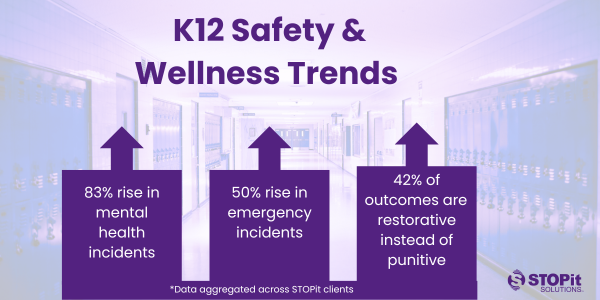Unlocking Potential: Why Mental Health in Schools is the Key to Student Success in 2024
The pandemic's ripple effects have washed over educators and students alike, leaving educators and students grappling with new realities. Mental health, once a simmering concern, has boiled over into a crisis demanding proactive solutions. A CDC study paints a grim picture: over 40% of students drowning in persistent sadness or hopelessness, and nearly 30% wrestling with broader mental health concerns. Educators are urgently searching for preventative strategies to bolster student well-being. The time for reactive approaches is over. A proactive, comprehensive mental health framework is the only way to navigate the challenges of our modern world and ensure every student thrives.
STOPit reports significant increases in incidents among its clients during the past year. See the data below.

Educators can’t turn away from the challenges of mental health in schools. With student mental health concerns at an all-time high, we can all agree this must be a top priority in 2024.
Links between Mental Health in Schools and Academic Success
Lower academic success is part of the fallout from not prioritizing mental health in schools. Students with mental health issues have higher drop-out rates, increased absences, poor grades, and overall lower educational outcomes. Other outcomes are even more devastating. We need only look at the rising suicide rate among young people, where it is the second leading cause of death among youth aged 10-25.
Four Major Stressors that Affect Mental Health in Schools
Children face more stressors than ever before, which can trigger or worsen mental health issues. These factors include:
1. Bullying and Cyberbullying
Reports of bullying are highest in middle schools (28%), followed by high schools (16%), and primary schools (9%). Social media, cell phones, and digital communications have added to this serious problem. Nearly half of U.S. teens report having been bullied or harassed online. Preventing bullying is a continuous process, not a one-time event. By incorporating these strategies into your daily practice, you can create a school environment where all students feel safe, respected, and empowered to thrive.
- Build a nurturing school culture where all students feel safe and valued.
- Set school policies for how students should treat each other, with adults as models.
- Cultivate students’ abilities to advocate on behalf of themselves and others.
- Provide a convenient, anonymous reporting system so the school can intervene as early as possible.
Additional Resources:
- StopBullying.gov: https://www.stopbullying.gov/
- The National Bullying Prevention Center: https://www.pacer.org/bullying/
- The Trevor Project: https://www.thetrevorproject.org/
2. Lack of Basic Needs
According to the NIH (National Institutes of Mental Health), students who have inadequate food, financial means, housing, transportation, communication, and medical care are more likely to experience poor mental and physical health, as well as lower academic performance than peers who do have these disadvantages. Here are three ways to make a difference. Small actions can make a big difference. By becoming a resource hub, fostering open communication, and ensuring that the community can access resources, educators can play a critical role in ensuring that every student has the opportunity to reach their full potential.
- Become a resource hub and provide direct access to local organizations that provide food assistance, housing support, healthcare services, and other vital resources.
- Foster open communications. Create a safe and welcoming space where students feel comfortable confiding in you about their needs. Normalize the discussion of basic needs challenges and emphasize that seeking help is a sign of strength.
- Translate information into multiple languages based on the school population.
Additional Resources:
- National Association of School Social Workers: https://www.nasw.org/: https://www.nasw.org/
- Feeding America: https://feedingamerica.org/: https://feedingamerica.org/
- National Low Income Housing Coalition: https://nlihc.org/: https://nlihc.org/
3. Social Isolation and Loneliness
Loneliness is associated with poor academic outcomes, along with bullying, substance abuse, and depression. Adolescents who reported they are lonely are more likely to drop out of school at 16 years old. Here are four strategies you can use to create a safe and supportive environment where every student feels valued, connected, and empowered to thrive.
- Assign collaborative projects that promote conversation and connection.
- Change the classroom environment by arranging the physical space to promote socialization.
- Normalize the discussion of emotions in the classroom setting.
-
Discretely explore the situation by reaching out to students who appear isolated.
4. Stressful Events that Lead to Thoughts of Suicide
Suicide prevention is a crucial topic, and nowhere is it more important than in schools. As educators, we have the opportunity to be trusted adults in the lives of our students, potentially playing a vital role in identifying and supporting those struggling with suicidal thoughts. However, navigating this sensitive topic requires both awareness and caution. Remember, we are not mental health professionals; our primary goal is to connect students with the appropriate resources when needed. Here are three ways we can recognize potential warning signs and offer support:
- Notice changes in behavior. Provide professional development for early detection of mental health signals and appropriate intervention.
- Identify struggling students early and intervene quickly. Implement a multi-tiered approach of support (MTSS).
- Normalize asking for help. Promote mental health awareness among students and parents.
Additional Resources:
- Shining Light on Suicide Awareness Month: 40 Vital Resources to Get Help
- The National Suicide Prevention Lifeline: 988
- The Crisis Text Line: Text HOME to 741741
- The Trevor Project: 1-866-488-7386
- The Jed Foundation: https://jedfoundation.org/
Seven Steps for Better Mental Health in Schools
1. Build a Supportive School Environment
Parent involvement has been shown to contribute to positive academic achievement, greater emotional and behavioral strengths, improved parent-teacher and teacher-student relationships, and fewer health risk behaviors, such as substance abuse. The school environment can provide a safe haven.
- Learn how to be culturally sensitive about emotional and mental health issues.
- Normalizing students advocating and asking for help for themselves and others.
- Promote and teach how to appreciate the perspective of others, tying it into classroom lessons.
2. Emotional Intelligence and Life Skills (SEL)
Whether they have a diagnosis or not, students can learn how to control their emotions better, empathize with others, embrace persistence, and think creatively. Emotional skills also foster soft skills, such as collaboration and communication.
- Create classroom and school environments where students feel valued and part of a community of learners.
- Create a code of school behavior that adults model and students have opportunities to demonstrate.
- Provide professional development to support teachers in applying related teaching techniques.
3. Family and Community Engagement
Building a community that supports positive mental health in schools requires the participation of students, educators, local businesses, community leaders, and other area resources. It is critical to develop mutually acceptable goals and plans.
- Include families and community organizations in discussions and plans to address student mental health issues.
- Enable students and families from diverse backgrounds to bring their personal thoughts, feelings, and experiences into the school environment.
- Develop a mentoring program, volunteering opportunities, workshops, and long-term partnerships with local businesses and non-profits.
4. Resources and Support
Many resources and hotlines are available, including some focused on specific populations, such as the LGBTQ community. Schools can promote the availability of resources and provide direct connections to appropriate school and community help resources. National mental health hotlines and resources include:
- Crisis Text Line: Text HOME to 741741 to connect with counselors 24/7/365
- SAMHSA’s National Helpline, a 24/7/365 treatment referral and information service (1-800-662-HELP (4357)
- National Suicide Prevention Lifeline, available by dialing 988 or 1-800-273-TALK (8255)
- National Alliance on Mental Illness (NAMI) Teen & Young Adult HelpLine for nationwide peer support and resource referrals. Text "Friend" to 62640; chat at nami.org/talk to us; call 800-950-6264 Mondays through Fridays, 10 a.m. to 10 p.m. ET.
- Trevor Project: Crisis intervention and suicide prevention services to lesbian, gay, bisexual, transgender, and queer young people under 25 (1-866-488-7386) or text “START” to 678678.
5. Professional Development
Teachers are on the front lines in identifying, intervening, and supporting kids who are in trouble. Learn about professional development programs from these and other sources:- National Education Association (NEA): Social-Emotional Learning (SEL) Courses
- Institute for Social & Emotional Learning (IFSEL)
6. Funding Sources for School-Based Mental Health Programs
National grants are available for local school districts, such as those below. States also have programs to support school mental health initiatives. Find out more from these national agencies:
- Overcome Obstacles to Funding Student Mental Health and Safety Programs
- National Education Association (NEA)
- Office of Elementary and Secondary Education
- SAMHSA Department of Mental Health and Human Services
7. Technology Tools for Mental Health Support
While fostering strong parent, school, and community connections is the cornerstone of supporting student mental health in schools, technology can be a valuable ally. New technologies are not meant to replace human interaction and support. However, they can effectively complement these efforts with thoughtful integration.
Types of tools to consider include:
- Teletherapy platforms
- Mental health apps
- Anonymous reporting systems
- Peer-to-peer support platforms
- Social-emotional learning (SEL) curriculum platform
- Data analytics tools
A Multi-Faceted Approach to Student Mental Health
The best way for students to succeed is by being valued in a safe, nurturing school community that values diversity and differences. Our communities rely on us to address mental health in schools, and it’s a priority we must take seriously in 2024 and beyond—with investment, training, and building relationships with parents and the community.



